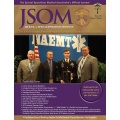Energy Balance and Diet Quality During the US Marine Corps Forces Special Operations Command Individual Training Course
Sepowitz JJ, Armstrong NJ, Pasiakos SM 17(4). 109 - 113 (Journal Article)
Methods: This study characterized the total daily energy expenditure (TDEE), energy intake (EI), body weight, and diet quality (using the Healthy Eating Index-2010 [HEI]) of 20 male US Marines participating in the 9-month US Marine Corps Forces Special Operations Command Individual Training Course (ITC). Results: TDEE was highest (ρ < .05) during Raider Spirit (RS; 6,376 ± 712kcal/d) compared with Survival, Evasion, Resistance, and Escape (SERE; 4,011 ± 475kcal/d) School, Close-Quarters Battle (CQB; 4,189 ± 476kcal/d), and Derna Bridge (DB; 3,754 ± 314kcal/d). Body mass was lost (ρ < .05) during SERE, RS, and DB because EI was less than TDEE (SERE, -3,665kcal/d ± 475kcal/d; RS, -3,966 ± 776kcal/d; and DB, -1,027 ± 740kcal/d; p < .05). However, body mass was restored before the start of each subsequent phase and was not different between the start (86.4 ± 9.8kg) and end of ITC (86.7 ± 9.0kg). HEI score declined during ITC (before, 65.6 ± 11.2 versus after, 60.9 ± 9.7; p < .05) because less greens or beans and more empty calories were consumed (ρ < .05). Dietary protein intake was lowest during RS (0.9 ± 0.4g/kg) compared with all other phases, and carbohydrate intake during RS (3.6 ± 1g/kg), CQB (3.6 ± 1.0g/kg), and DB (3.7 ± 1.0g/kg) was lower than during the academic phase of SERE (5.1 ± 1.0g/kg; p < .05). Conclusion: These data suggest that ITC students, on average, adequately restore body mass between intermittent periods of negative energy balance. Education regarding the importance of maintaining healthy eating patterns while in garrison, consuming more carbohydrate and protein, and better matching EI with TDEE during strenuous training exercises may be warranted.


 Español
Español 




